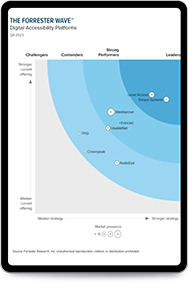Navigating International Accessibility Laws
Aug 10, 2021
Digital accessibility compliance is complex, especially for organizations doing business on a global scale. Markets around the world have adopted their own accessibility regulations, and to operate internationally, organizations must simultaneously adhere to multiple international mandates.

Managing compliance across a diverse set of jurisdictions can be challenging—and if you’re unsure where to start, we’re here to help. In this post, we’ll provide an overview of notable international accessibility laws and standards and offer some quick tips for streamlining the management of a global digital accessibility program.
WCAG: The global standard for digital accessibility
Many international digital accessibility laws have adopted the same standard for compliance: the Web Content Accessibility Guidelines (WCAG). WCAG was developed by the World Wide Web Consortium (W3C) to help ensure digital content is accessible to all users, including people with disabilities. These guidelines are regularly updated to keep pace with the changing technology landscape, and the most recent version, WCAG 2.2, was released in September 2023. Different versions are backwards compatible, so if a website conforms with WCG 2.2, it will also conform with WCAG 2.1.
There are three levels of conformance with WCAG: A, AA, and AAA, where A represents the minimum level of conformance and AAA represents the highest level achievable. WCAG AA is widely considered the benchmark for accessibility, and most laws and standards that incorporate WCAG require this conformance level.
The Must-Have WCAG Checklist
Major international accessibility laws
The following portion of this blog summarizes international laws governing the accessibility of websites, apps, and other digital experiences, organized by market:
- United States
- Canada
- European Union
- France
- Germany
- United Kingdom
- Norway
- Israel
- Australia
- New Zealand
- Japan
- Korea
While many of these are workplace and anti-discrimination laws that aren’t limited to digital accessibility, they have implications for the digital world.
United States
Americans with Disabilities Act (ADA)
The ADA is an anti-discrimination law that offers equal protection to people with disabilities in the U.S. across many areas, from employment to transportation. Title III of the ADA mandates that people with disabilities have equal access to “public accommodations,” a broad category that the U.S. Department of Justice (DOJ) has repeatedly clarified includes websites available to the public.
Separately, Title II of the ADA requires that state and local government programs and services—including digital experiences associated with these programs and services—are accessible, and don’t discriminate against users with disabilities. In 2024, rulemaking implementing Title II was updated to clarify that Level A and AA conformance with the Web Content Accessibility Guidelines (WCAG) version 2.1 is the compliance standard for websites, other web content, and mobile apps (including content from third-party organizations).
Section 508 of the Rehabilitation Act of 1973
Section 508 requires that U.S. federal agencies ensure the accessibility of their information and communications technology (ICT), which includes websites, software, and mobile apps as well as digital documents and hardware. The law adopts WCAG 2.0 Level A conformance as the standard for compliance. Notably, public-sector vendors selling ICT to the U.S. federal government must also meet Section 508’s digital accessibility requirements.
Section 504 of the Rehabilitation Act of 1973
Section 504 mandates that the U.S federal government and recipients of federal government aid and assistance, including public schools and universities and healthcare facilities, offer people with disabilities equal access to their programs and services. The law applies to websites and digital content associated with these programs and services.
21st Century Communications and Video Accessibility Act (CVAA)
The CVAA aims to ensure that people with disabilities have equal access to “advanced” communication services, such as digital two-way communication, broadband, video programming, and mobile products and services. The Act includes specific accessibility requirements for these communications technologies, and non-compliance can be costly: organizations may face fines up to $100,000 per violation, with a maximum penalty of one million dollars per day.
Air Carrier Access Act (ACAA)
The Air Carrier Access Act protects people with disabilities from discrimination by U.S. airports and airlines, including international airlines entering or exiting the U.S. In addition to outlining physical accessibility requirements for air travel, the law mandates that airports and airlines ensure their websites meet WCAG 2.0 level A and AA criteria. The ACAA also includes specific technical accessibility requirements for self-service kiosks.
Section 1557 of the Patient Protection and Affordable Care Act (ACA)
Section 1557 of the ACA prohibits discrimination based on many factors, including disability, in covered health programs and activities. The law does not specify a technical accessibility standard for compliance.
Canada
Accessibility for Ontarians with Disabilities Act (AODA)
The AODA requires that all organizations based in Ontario, regardless of size, sector, or industry, adhere to accessibility standards in five key areas—customer service, employment, information and communications, transportation, and public spaces —and outlines specific digital accessibility requirements. To comply with the information and communications area of the law, organizations must ensure their websites, web content, and web-based applications conform with WCAG 2.0 level A and AA criteria, with exceptions for audio descriptions and live captions on video content.
Your roadmap to AODA compliance
Accessible Canada Act (ACA)
The ACA provides for the development of accessibility standards and gives the Government of Canada the authority to work with stakeholders and people with disabilities to create new accessibility regulations that will apply to sectors within the federal jurisdiction. The ACA also sets requirements for organizations to follow in order to identify, remove, and prevent barriers to accessibility.
Canadian Radio-television and Telecommunications Commission (CRTC) Accessibility Reporting Regulations
Under the ACA, the CRTC has implemented various accessibility reporting rules for broadcasting and telecommunications organizations in Canada. These regulations include requirements for broadcasting and telecommunications service providers to establish accessibility feedback processes and publicly report their accessibility progress.
Canadian Charter of Rights and Freedoms
This law protects the human rights of all Canadian citizens, including protection from discrimination on the basis of disability.
Canadian Standard on Web Accessibility
The Canadian Standard on Web Accessibility requires all Canadian government websites and web applications to conform to WCAG 2.0 AA. Like Section 504 and 508 in the U.S., the Canadian Standard on Web Accessibility applies to public-facing web pages and web apps provided through federal government agencies.
European Union (EU)
Note: The following international accessibility laws apply to Austria, Belgium, Bulgaria, Croatia, Cyprus, Czechia, Denmark, Estonia, Finland, France, Germany, Greece, Hungary, Ireland, Italy, Latvia, Lithuania, Luxembourg, Malta, Netherlands, Poland, Portugal, Romania, Slovakia, Slovenia, Spain, and Sweden.
European EN 301 549 Standard
EN 301 549 is the European standard for digital accessibility. Similarly to Section 508 in the U.S., this standard sets requirements for the ICT of public-sector organizations in the EU. EN 301 549 criteria cover websites and mobile apps, as well as a wide range of ICT products and services, including telecommunications services. The standard, which currently incorporates WCAG 2.1 A and AA, may be used in procurement and is the presumptive standard of compliance for other EU accessibility regulations.
Directive EU 2016 / 2102 (Web Accessibility Directive)
This Directive requires the websites and mobile apps of all public-sector organizations in the EU to be accessible for people with disabilities. EN 301 549 is the standard for compliance.
European Accessibility Act (EAA)
The European Accessibility Act mandates that a range of products and services, including e-commerce websites and many types of digital experiences, are accessible to consumers with disabilities. Notably, the law applies to any organization conducting business in the EU—not just those based in the EU. Enforcement of the Act will begin in June of 2025, and EN 301 549 will be used as the presumptive standard for conformity.
Get clarity on EAA compliance
France
Law 2005-102 and the General Accessibility Reference Framework for Associations (RGAA)
Law 2005-102 is an anti-discrimination law that mandates the accessibility of public online communication, including websites, intranet systems, mobile applications, and software. Compliance is required for all public-sector organizations in France, as well as private-sector organizations with an annual revenue of over 250 million Euros. The standard for compliance with Law 2005-102 is the RGAA, a French digital accessibility standard based on WCAG 2.1 Level A and AA.
Germany
Berlin Barrier-free Information Technology Ordinance (BITV)
The BITV is a piece of legislation that protects the equal rights of people with disabilities to access information and communications technology. Based on the Gesetz zur Gleichstellung von Menschen mit Behinderungen (BBG), a German law that prohibits discrimination based on disability by federal public entities, the BITV extends the BBG’s accessibility requirements for government buildings and public spaces to the digital world.
The BITV includes specific accessibility guidelines adapted from WCAG 2.0, and compliance is mandatory for all federal public-sector organizations in Germany.
United Kingdom
The Equality Act of 2010
The Equality Act prohibits both public- and private-sector organizations in the U.K. from discriminating against people with disabilities in employment and when providing products, facilities, and services.
Public Sector Bodies Accessibility Regulations
The Public Sector Bodies Accessibility Regulations mandate that public-sector organizations in the U.K. ensure their websites and mobile content are accessible to people with disabilities. The regulations adopt EN 301 549 as the standard for compliance.
British National Standard (BSI 8878)
The British Standards Institution, or BSI, published the British National Standard as a Code of Practice for developing processes to plan and create accessible web experiences.
Norway
The Equality and Anti-Discrimination Act
The Equality and Anti-Discrimination Act establishes digital accessibility requirements for both public- and private-sector organizations in Norway. While EN 301 549 is the compliance standard for public-sector organizations, private-sector organizations must meet WCAG 2.0 level A and AA criteria with some exceptions.
Israel
Israel Standard (IS) 5568
IS 5568 is Israel’s national standard for web accessibility. It applies to public and private organizations in India and incorporates WCAG 2.0 AA.
Australia
Disability Discrimination Act (DDA)
The DDA prohibits individuals and organizations in Australia from discriminating against people with disabilities in several areas, including education, employment, and the provision of goods and services. Digital accessibility barriers may constitute an act of discrimination under the DDA, and the Australian Human Rights Commission recommends WCAG 2.0 AA conformance as a baseline for compliance.
AS 301 549
Adapted from the U.K. standard EN 301 549, AS 301 549 establishes specific accessibility requirements for digital products procured by public-sector organizations in Australia under the Digital Services Standard.
New Zealand
New Zealand Human Rights Act
This human rights law protects the rights of all people in New Zealand and prohibits discrimination based on a range of factors including disability.
Web Accessibility Standard 1.1
All public service and non-public service agencies in New Zealand must meet the requirements of Web Accessibility Standard 1.1. This standard incorporates WCAG 2.1 AA criteria, with exceptions for complex maps, alternatives for time-based media, live captions, and audio descriptions.
India
Rights of Persons with Disabilities Act
The Rights of Persons with Disabilities Act is an Indian anti-discrimination law that offers various protections to people with disabilities, including equal access to both physical and digital spaces. The law applies to both public and private entities in India and has adopted a version of EN 301 549—EN (IS) 301 549 (parts 1 and 2)—as the compliance standard.
Japan
Japanese Industrial Standard X 8413-3 (JIS X)
JIS X provides specific guidelines, derived from WCAG 2.0, for planning and developing digital content that is accessible to people with disabilities and the elderly. Conformance with these guidelines is mandatory for public-sector organizations and voluntary for private-sector organizations.
Korea
Act On the Prohibition of Discrimination Against Persons with Disabilities and Remedy Against Infringement on Their Rights
This Act outlaws discrimination against people with disabilities in many areas, including employment, education, and the provision of goods and services. Article 20 of the Act explicitly protects people with disabilities’ equal right to access information, including electronic information, from both public and private organizations.
Legal support for your global organization
Tips for streamlining global accessibility compliance
Achieving and maintaining compliance with the myriad international accessibility laws is no small feat—but with the right processes in place, organizations can efficiently and consistently meet their obligations. Here are a few pieces of advice:
- Conform with the latest version of WCAG: As the global standard for digital accessibility, WCAG serves as the benchmark for compliance with numerous international digital accessibility laws. Because different laws and standards have adopted different versions of WCAG, and versions are backwards compatible, targeting conformance with the most recent version will help you meet many global accessibility requirements simultaneously while staying ahead of future regulatory changes.
- Establish organization-wide accountability for accessibility: When an individual or team is centrally accountable for accessibility across your organization, it’s easier to ensure that digital experiences across your portfolio are held to consistent accessibility standards that align with international requirements. In fact, according to our Fifth Annual State of Digital Accessibility Report, professionals at organizations with centralized accountability for digital accessibility report higher program maturity, and reduced legal risk, relative to those whose organizations’ lack centralized oversight.
- Leverage tooling to support accessibility governance: Digital experiences are dynamic—and sustain compliance, organizations need a reliable system for tracking their conformance with accessibility standards over time. Governance tools, like those in the Level Access Platform, can help streamline this work by providing a unified view of the high-level accessibility status of an entire digital portfolio, as well as individual assets, and allowing organizations to benchmark performance against specific thresholds.
Advance accessibility at scale with a trusted partner
Successfully navigating global compliance requires technology and expertise. An experienced third-party digital accessibility provider, like Level Access, can equip you with the tools and guidance necessary to meet your legal obligations across markets. Engage with a member of our team to get started, or learn more about our enterprise solution here.
Your partner for streamlined, scalable accessibility
Subscribe for updates

